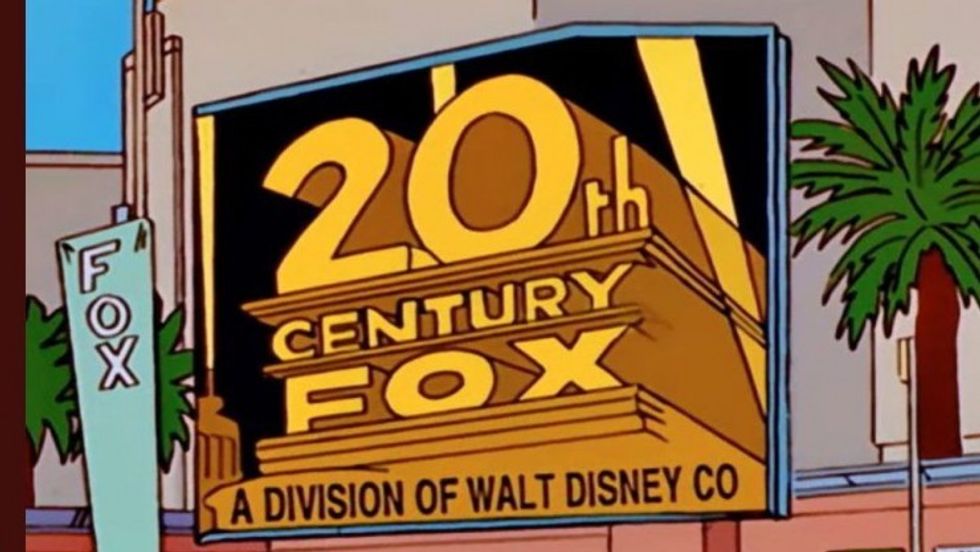Why Disney+ Cropping 'The Simpsons' and Other Issues Are Huge Problems for Filmmakers
Disney+ is a hit with most fans, but the new streaming service has some problems -- especially when it comes to cropping shows and airing them in their incorrect aspect ratios after telling fans they wouldn't.

Last week, Disney+ launched and, by all accounts, the company's new direct-to-consumer streaming platform is a smash content-wise, with over 10 million downloads on day one alone. (I haven't heard ten people talk about Apple TV+, much less 10 million.)
But as the platform rolled out on Tuesday, November 12, there were some significant technical hiccups (some quickly resolved) and also some issues with the content that are way more troubling, especially for filmmakers looking to exhibit content on Disney+.
The biggest issue so far, especially if we're going by the metric of Twitter outrage, has to do with Disney+'s presentation of Matt Groening's beloved animated series The Simpsons. Following Disney's acquisition of Fox, it was announced that 600+ episodes of the groundbreaking sitcom would debut, alongside classic Disney films and projects from Marvel Studios, Pixar and Lucasfilm, on the brand new platform. This was a huge win for consumers, especially given Disney+'s seductive $6.99 a month price point (with Verizon users getting an entire year free).
But the devil is in the details. And of the 661 episodes of The Simpsons currently available on Disney+, a whopping 429 of them were made before HD upgrades. That means that those 429 episodes, originally broadcast in the boxy 4:3 aspect ratio, have been artificially stretched to accommodate widescreen TVs. Shows have had to retroactively upgrade their formatting in the past few years; the best of them, like The Wire, lose little of the original visual integrity while presenting the material for optimized, next-gen technology.
When it goes bad, as is the case for the Buffy the Vampire Slayer "upgrades," it can go spectacularly bad (you can see additional crew members in certain shots and they didn't go back and redo the digital color timing). The Simpsons, unfortunately, is closer to the latter.
To add insult to injury, the Disney+ Help team was telling customers that the episodes would run, unaltered, on the new platform, months before the November 12 launch.
There are other aspects of the new platform that should worry filmmakers. On launch day, Frank Angones, executive producer and writer of the terrific new DuckTales series, took to Twitter to post the episode order of the series, since Disney+ had uploaded the episodes incorrectly.
You might think that this wouldn't matter much, since DuckTales is a kids' TV show, but the show is actually highly serialized, with narrative throughlines stretching across episodes and seasons. Seeing the episodes out of order would be catastrophic to your enjoyment of the series. Other shows have been uploaded in a similarly jumbled fashion. For example, the two-part "Darkly Dawns the Duck" pilot episode of Darkwing Duck, meant to introduce audiences to the characters and the world, are listed as episodes 29 and 30 of the first season on Disney+.
Just as distressing (and twice as weird) is the fact that Disney, for some reason, has heavily edited one of the characters in Gravity Falls (arguably the most serialized animated Disney show ever and one whose episodes are, thank the lord, presented in order). The show's creator Alex Hirsch noted on Twitter how Disney had erased the symbol on Grunkle Stan's fez for the actual episodes but, hilariously, the symbol remains on the thumbnail images for the episodes. (It also remains in one of the subliminal images during the opening credits sequence -- at least for now.) Controversy had surrounded the symbol due to its closeness in appearance to a Shriner emblem, and was changed between episodes 12 and 13 of the first season to a symbol created by Hirsch and the artistic team (resembling a mackerel) that they maintained for the rest of the series. Why Disney would erase it outright (and not tell the creator) is baffling indeed.
Also, films that shift aspect ratios (a stylistic flourish that is particularly popular this Oscar season) are left out in the cold. Bird's Oscar-winning Pixar film, The Incredibles, begins with old, black-and-white interview footage of the heroes, presented in an era-appropriate 4:3 aspect ratio. That ratio should fill the whole screen from top to bottom, just like the episodes of Adventures of the Gummi Bears you can watch on Disney+ right now, before shifting, after the title card, into a more cinematic widescreen format. Only it doesn't play that way on Disney+.
Instead of filling the screen from top to bottom, it's squeezed into a small cube in the center of the frame, within the boundaries of the rest of the widescreen presentation. ("Picture-boxed" is how that kind of image, with bars on the top and bottom and sides, is commonly referred to.) If anyone could figure out how to make this work seamlessly, it's Disney, a company that is known for its technological innovation and visual ingenuity. It feels especially off-base considering how many of the original animated shorts and features are airing on Disney+ unaltered, with just a note about how the content might feature "outdated cultural depictions" in things like Dumbo. (I was watching the lone episode of the Wonderful World of Disney on Disney+ and even that warned about depictions of smoking.)
Given that this is arguably the most important move Disney has made in 35 years and certainly is the most technologically advanced presentation of any of its content, the studio should work to ensure that the filmmakers' original vision is secure throughout. Disney+ should be the optimum place to watch content from the company's many brands.
Hopefully that'll happen, sooner rather than later.












